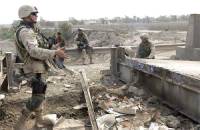
[Enlarge
Image] Capt. Marc J. Distefano A Co. commander, 20 ENG Bn., 1st Cav.
Div. supervises his crew as they fix a bridge in Baghdad. (U.S. Army Photo
by Pfc. Erik LeDrew, 122nd Mobile Public Affairs Detachment)
May 4, 2004
By Pfc. Erik LeDrew, 122nd Mobile Public
Affairs Detachment
|
|
While some Soldiers are bridging the
cultural and communication gap between the local Iraqi people, the Engineers are
out building and repairing bridges for the Iraqi people. Alpha Co., 20th
Engineer Battalion of the 1st Cavalry Division, began repairs on a bridge in
Baghdad that had been recently damaged by insurgent forces.
“While conducting an assessment of the
bridge, we found out that the ramps had been blown apart by charges on the south
side of the bridge,” Capt. Marc J. Distefano, Alpha Co. commander said.
“Whoever did it apparently didn’t know how to use charges too well, or the
whole bridge would have come down. However, they did pretty much destroy two of
the ramps.”
Distefano said, the damaged bridge is
actually two, one-lane bridges that support traffic going both south and
northbound where it crosses the Diyala River in northeastern Baghdad. Repair of
the heavily trafficked bridge was necessary for both the Iraqi working
population and coalition forces.
“The bridge was put in last year by the
Marines, who are really the subject matter experts on this type of bridge,”
said Distefano, whose Mechanized Engineer unit is trained mainly for breaching
and explosive ordnance disposal (EOD). “However, because there was only damage
to the ramps and no structural damage we felt we could make the repair.”
According to Distefano, there were three
phases involved in repairing the bridge.
|
|
Phase one included making a damage
assessment; phase two included taking parts from one damaged bridge in order to
fix the other less-damaged one, and phase three will entail either coordinating
with a contractor to help make the second bridge functional.
“Most of what we had to deal with today
was corrosion and dirt where the bolts to the ramp were,” said 1st Lt. William
Abel of the 20th Eng. Bn.. “But we have a great welder who helped us take care
of the rusted bolts.”
According to Abel, who performed the damage
assessment of the bridge, it was difficult to try and explain to the local
Iraqis why the bridge had been closed.
“A lot of people wanted to know what we
were doing out there and I tried to explain to them that we were fixing the
bridge,” he said, “Things like this are a great way of building positive
relations with the Iraqi people.”
“Anything we do that’ll help the Iraqis
is a step in the right direction,” Distefano said.
|
|
According to Distefano, his unit was given
a 48-hour time-frame to complete repairs on at least one of the two bridges.
“We went out and did a recon and an
assessment of the damages, and then we looked into our own organization to see
what internal assets we had that might help us repair this bridge,” he said.
“Then we made our plans and were able to execute them the next morning.”
Distefano said he hopes that his unit will
have the opportunity to work on other projects like this, despite the time
constraint.
“A lot of engineers don’t get many
construction projects like this because the emphasis has been on mobility and
breaching,” he said. “So anytime we can do construction, it’s
well-received.”